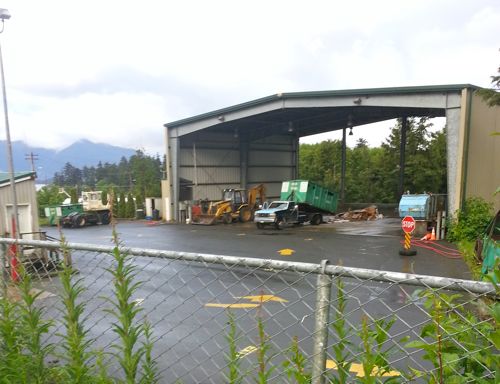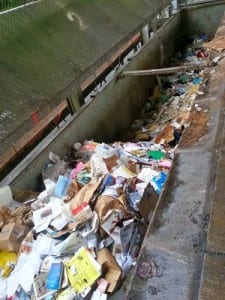
This load of mixed paper recycling was dumped in June — one of three loads dumped this year due to food contamination. (KCAW photo)
Sitkans who saw a truck hauling one of the city’s large, green recycling bins up Jarvis Street to the waste transfer station earlier this summer were not imagining things. The contractor responsible for managing Sitka’s recycling dumped a total of three loads of mixed paper after discovering they had been contaminated by food waste.
Dumping recyclables after they’ve been sorted and delivered by residents is not common — but it happens regularly, usually in the spring and early summer.
Well, how do you know that an entire bin of mixed paper is contaminated? Gary Baugher, Sitka’s maintenance and operations superintendent, knows how.
“You could actually smell the putrescible waste in there, or fish or something like that. It just smelled so bad that they didn’t want to put it in the stream going down south.”
Except for glass bottles and biosolids collected at the sewage treatment plant, every ounce of waste in Sitka is loaded or baled, weighed, and shipped to Seattle, under contract with Alaska Pacific Environmental Services — the guys who drive the blue garbage trucks around.

Baled up and sold on the commodities market, a load of recyclables can be sold for about $180/ton. Shipped south as trash, it costs Sitka $150/ton. (KCAW photo)
The contract begins the moment you open the lid of your home trash container or dumpster, or drop off a load of recyclables.
“Ultimately, when waste goes in the recycle bin at the facility, or in the trash can, they essentially own that waste.”
This is Michael Harmon, Sitka’s director of public works. He says, in theory, Alaska Pacific Environmental Services has the discretion to manage garbage and recycling any way they like. But APES, as it’s called, is delivering Sitka’s waste on Alaska Marine Lines to Seattle, where it’s turned over to Rabanco, the regional solid waste contractor.
As a general rule, Rabanco won’t accept recycling loads that are more than one-percent contaminated. In Sitka, where about 600 tons of recyclables move off-island every year, that doesn’t leave much wiggle room.
Harmon believes this is a drawback of our sort-and-deliver recycling system.
“You can come in and dump most any hour of the day, it’s kind of up to the community to do our best under that kind of system where it’s not controlled. That you don’t contaminate it. Then we’re going to get the credit back in clean recyclables. A good commodity price.”
Right now that price is a little over $180 a ton. That’s what Sitka gets back, on average, from selling its recyclables on the Northwest Commodities Market. $180 a ton is about $30 more than what Sitka pays to ship garbage south. So we’re coming out slightly ahead on the deal at the moment.
With real money at stake, it’s worth it to keep Sitka’s recycling loads clean. Harmon doesn’t know why every spring two or three loads end up contaminated by food. He can imagine a scenario where a ship arrives in Sitka and unloads its recyclables — but it doesn’t have to be a ship.
“Any type of organization where you have a lot of people dumping into a recycle bin and they do a bad job of it. Say the end of a cafeteria line or something. And the intent is to get the cardboard in there, or the cups or whatever, and they do a really bad job and you get a mixed mess. And the worker says, Yup that’s the bin, for whatever type of recycling and they come in and dump it and don’t realize how badly it’s contaminated.”
While it’s easy to point a speculative finger at someone from outside of Sitka who doesn’t understand our recycling system, Gary Baugher says plenty of locals don’t quite get it either. Staff are having to do more of the sorting than the system is designed for.
“If the bins are full, usually the answer is that they put it beside the bins. But a lot of times it’s co-mingled with a lot of different materials, and they just take the bags and throw them into wherever the closest and most convenient place is.”
Sitka’s entire solid waste system is undergoing an in-house assessment. Of all municipal services, it’s probably the most likely candidate for being turned over to private-sector management. The payback in recycling helps make it an attractive business opportunity, and as things stand now, Sitkans are recycling only a fraction of the waste stream — just under 7-percent of the 8,000 tons of waste shipped south annually.
A more efficient system — possibly curbside pickup — could improve those numbers, but for now, Michael Harmon says breaking even on recycling is worth it.
“Sometimes it’s close to a wash, really, by the time you look at all the expenses against the commodity price back. Still, we’re recycling and that’s a good thing. And if we can do that for a wash or sometimes ahead, it’s great!”






























